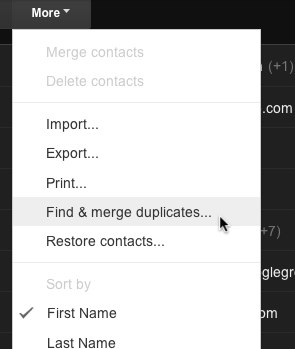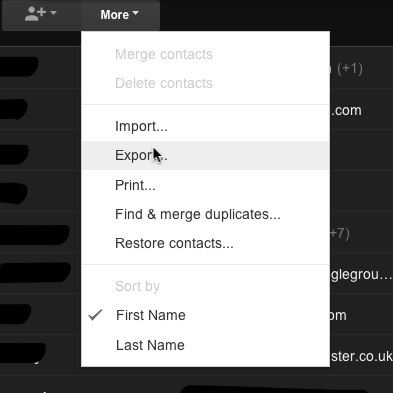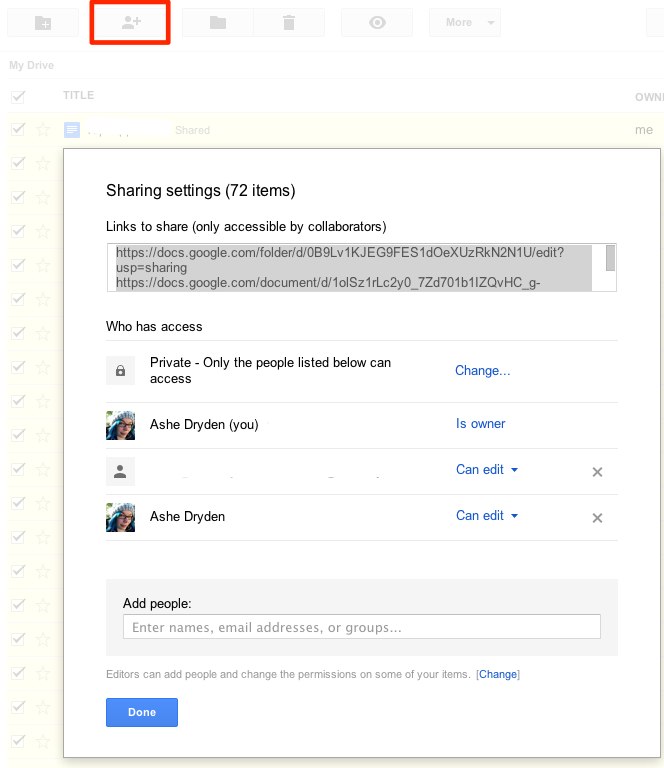Migrating Google Accounts
I signed up for gmail a few months after they released it, back when I was using a different name. Since then, I've added another google account using my present name but have been struggling with the fact that some things are in one place and others are in another place. I finally decided this past week to figure out how to move data from one into the other.
It wasn't important for me to be able to move absolutely everything over. I won't be deleting or disabling the old account, so I will still have access to everything as long as google allows me to keep that account. If you are losing access to your old account (if you are leaving an organization or business, for example), not all of this information will be relevant to you.
I focused on moving my email archive, contacts, calendars, documents, groups, reader, and related settings for each of those things.
Gmail: Email
Email was the biggest beast I was worried about. Having nearly 10 years of mail and needing to be able to search all of that pretty regularly meant that I couldn't just back them up and keep them as an archive somewhere, I needed them available with the rest of my mail.
In doing research on migrating mail, I found many people that said you couldn't export or migrate your labels. As someone with near a hundred labels, I was not looking forward to moving them over manually. I asked about it on twitter and someone was kind enough to point me at Gmvault.
@ashedryden I just merged one gmail account into another with gmvault a few days ago. Labels were kept fine.
— Deon Garrett (@deong) March 7, 2013
Gmvault is pretty neat. It's a command line utility that basically grabs and backups all of your email (labels included!) locally, then allows you to push it to another gmail account.
- Download Gmvault
- Install and start syncing your emails. This was a big process and took about 10hrs to complete, so start it when you're able to leave your computer running overnight without interuption.
- Push the emails to a new account. Note: they call this "restoring" in the documentation. Google throttles this which makes it take longer than the download, so allow this one to run at least overnight, too. It took me about 16hrs for 44K emails. You may get frequent status messages like "Cannot reach Gmail server, wait 4 seconds and retrying." It will keep trying until it gets through again, so don't worry about that.
As some people may still email you at your old address, don't forget to set up forwarding to your new address.
EDIT: It was brought to my attention that POP3 may be the easier/faster/more foolproof way to do this. I don't know if this will preserve labels or read status.
@ashedryden, just for the record: the POP3 migration for me is way better than gmvault. Essentially because all happens "in the cloud".
— Ignacio Bauer (@ignaces) March 10, 2013
- In your old account, go to settings, then Forwarding and POP/IMAP tab. Under POP Download, select Enable POP for all mail. Save changes.
- In your new account, go to settings, then the Forwarding and POP/IMAP tab. Under Check mail from other accounts (using POP3):, select Add a POP3 mail account of your own.
- Enter your old email address and credentials (note: if you are using two-step authentication, you will have to get an application specific password by going to your old account's main account settings and then to Security, and then to Connected Applications and Sites). Make sure pop.gmail.com and port 995 are selected.
- Depending on the number of emails you have this may take a while.
If you are using a desktop or phone email client, make sure set those up with your new credentials.
Gmail: Filters
Filters make dealing with the massive amounts of email I receive manageable. Over the years I've built up close to 60 of them and wanted to make sure that I preserved all of that information so switching accounts would be seamless. Thankfully google makes it easy to export and import these.
- From your old gmail account, click the gear to go into settings.
- Click the Filters tab.
- Scroll to the bottom and click the Select: All link and then the export button.
- Save the file to your computer.
- From your new gmail account, click the gear to go into settings.
- Click the Filters tab.
- Scroll to the borrom and click the Import Filters link.
- Select the file from your computer and click Open File.
If any of your filters were email address specific, you may need to change them. This is a good time to go through and cull the herd anyway, right? :}
Gmail: Settings and Configuration
Unfortunately there doesn't seem to be a way to export your settings. I just put two browser windows side by side and replicated the settings, including Labs.
Contacts
Contacts are another easily exportable set of data. Before you do the export, though, let's clean up them up a little. Because I sync my contacts from google to my iPhone address book and back, sometimes I get things that are out of sync or end up with duplicates.

- From within the contacts page in Gmail, click the More menu and select Find & Merge Duplicates.
- If there are any contacts to merge, you'll be presented with a dialog guiding you through what you'd like to merge. Make your selections.
Next we can do the actual exporting and importing.

- From the More menu, choose Export.
- Choose which contacts you'd like to export. I chose All Contacts.
- Choose the Google CSV format.
- Click Export.
- Save the file to your computer.
- From your new gmail account, navigate to the Contacts page.
- Choose Import from the More menu and select the file from your computer.
If you are syncing your contacts with your computer or phone, make sure to set those up with your new credentials.
Calendar: Calendars
Calendar data doesn't seem to be easily exportable, but if you aren't going to be losing access to your old account you can get around this by sharing the calendars and read/write access to them with your new account.
![]()
- From Google Calendar with your old account, click the gear and choose Settings.
- Select the Calendars tab.
- For each calendar, click the Sharing link.
- Enter the email address of your new account, choose Make changes AND manage sharing and click Add person.
- Save.
- Repeat for each calendar.
If others have shared calendars with you, you will need to ask them to reshare them with your new account.
If you are syncing calendars with your computer or phone, make sure you set those up with your new credentials.
Calendar:Settings and Configuration
Same thing here as with Gmail. You'll need to manual move this information over. Don't forget your reminders and notifications!
Documents
There are a couple ways you can migrate your documents over.
If you are using Google Drive and aren't worried about preserving the sharing/editing information of your documents (this works if you don't share documents with others for collaboration), you can use the desktop app (it works the same way as Dropbox, syncing a local folder to drive.google.com) to make a copy of the documents and add them into the new account's Google Drive folder.
If you do want to preserve the sharing/editing information and you will not be losing access to the old account, you can just share your documents with your new account.

- Select all documents.
- Click the Sharing button in the toolbar.
- Add your new email address as someone that can edit the document and click Done.
If others have shared documents with you, you will need to ask them to reshare them with your new account. Additionally, if people share documents with your old account, Google provides you with a handy link to request access using the currently logged in account.
Groups
Groups are probably the easiest to migrate.
If you are not the group owner or administrator, contact the owner/administrator and ask them to add your new account to the group.
If you do own or administrate the group:
- From the group's main page, click the Manage link in the upper right.
- Click the green Manage button.
- From the left sidebar under the Members section, click Direct Add Members.
- Enter your new email address, a welcome message, and your email subscription options. Click Add.
- From the Manage page, check the box next to your new account's name.
- From the Actions menu, choose Add to role: owner.
You will also need to manually migrate your settings for each group. You can do this, again, by just using two browser windows next to each other. You can find these settings under the My Settings menu and then choose Membership and Email Settings.
Reader
I still use an RSS reader (I know, I know) and I have years of subscriptions built up in there. The process of migrating your subscriptions is very easy, although it isn't very obvious.
- From your old account, open up Reader and navigate into settings through the gear icon.
- Select the Import/Export tab and click Down your data through Takeout. Note: make sure you aren't logged into your new account, because this will confuse the redirect. It took me a while to figure that one out.
- Click the Create Archive button and download your data.
- Unzip the file.
- From your new account, open up Reader and navigate into settings through the gear icon.
- Select the Import/Export tab and click the Browse/Choose File button. Select the subscriptions.xml file from the Reader directory within the takeout directory that you downloaded and unzipped.
- Click Upload.
Other Things to Keep in Mind
- You can see an overheard view of the things that are associated with your google account through the Google Dashboard.
- If you are using two-step authentication or have connected applications or sites for your old account, make sure you set that up for your new account.
- If you are using your email address for logging into sites and services, consider having your email address changed on those sites. If you use a password manager like 1password, it should be easy to search and find which sites are using your old email address.
- Start this process knowing that you'll spend a week or so in both accounts making sure you didn't forget anything. There will always be accounts connected that you'll have forgotten about.